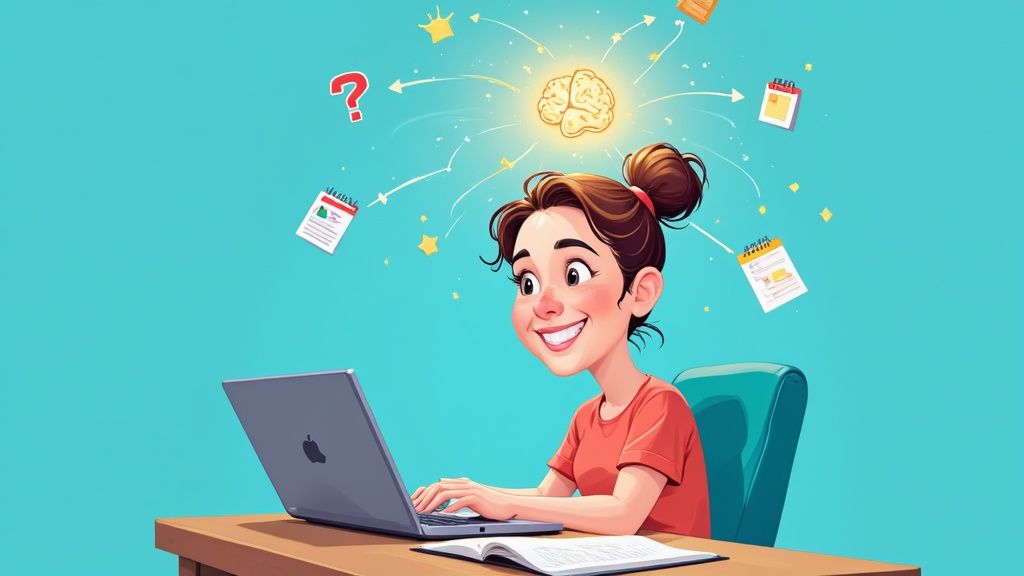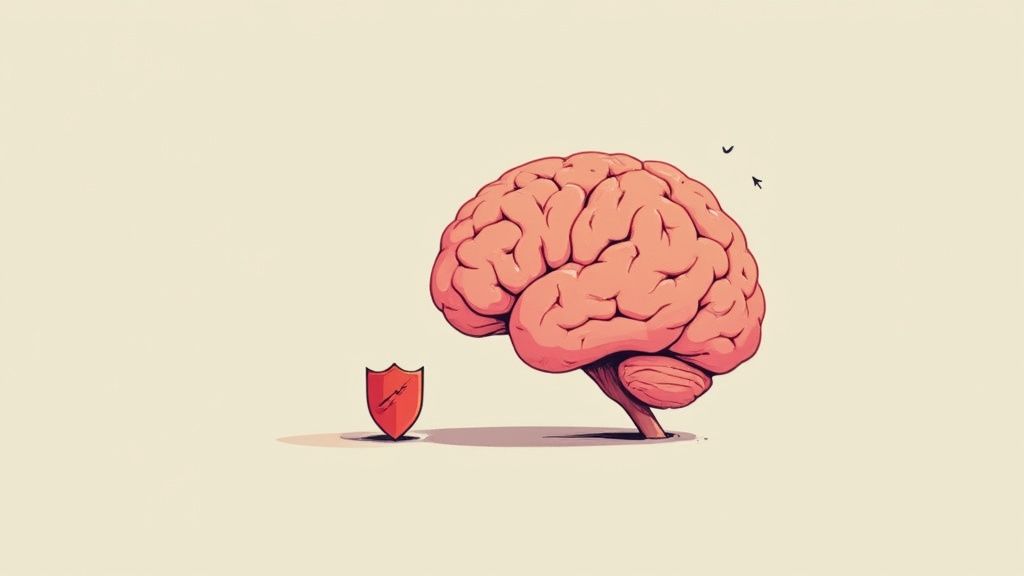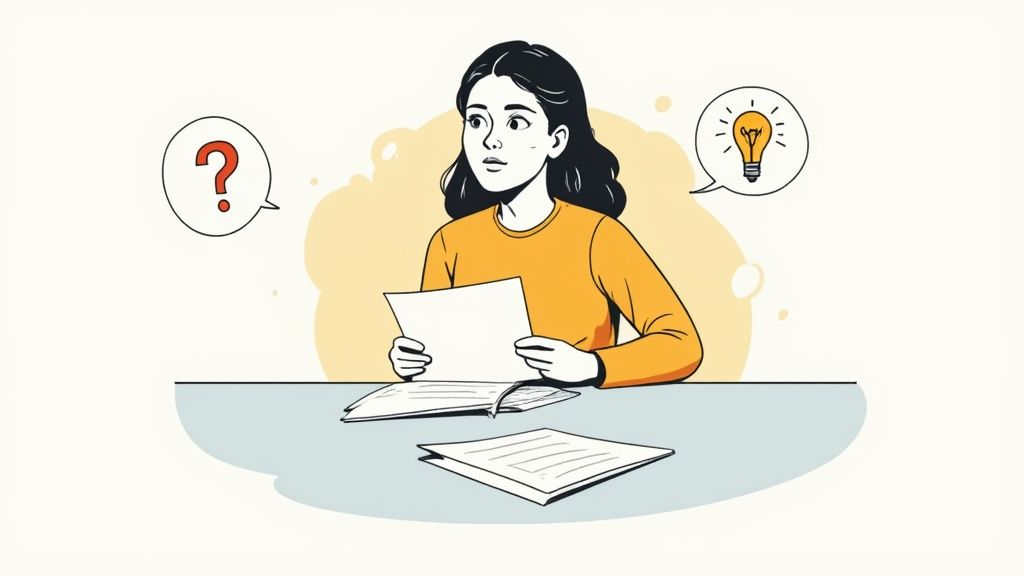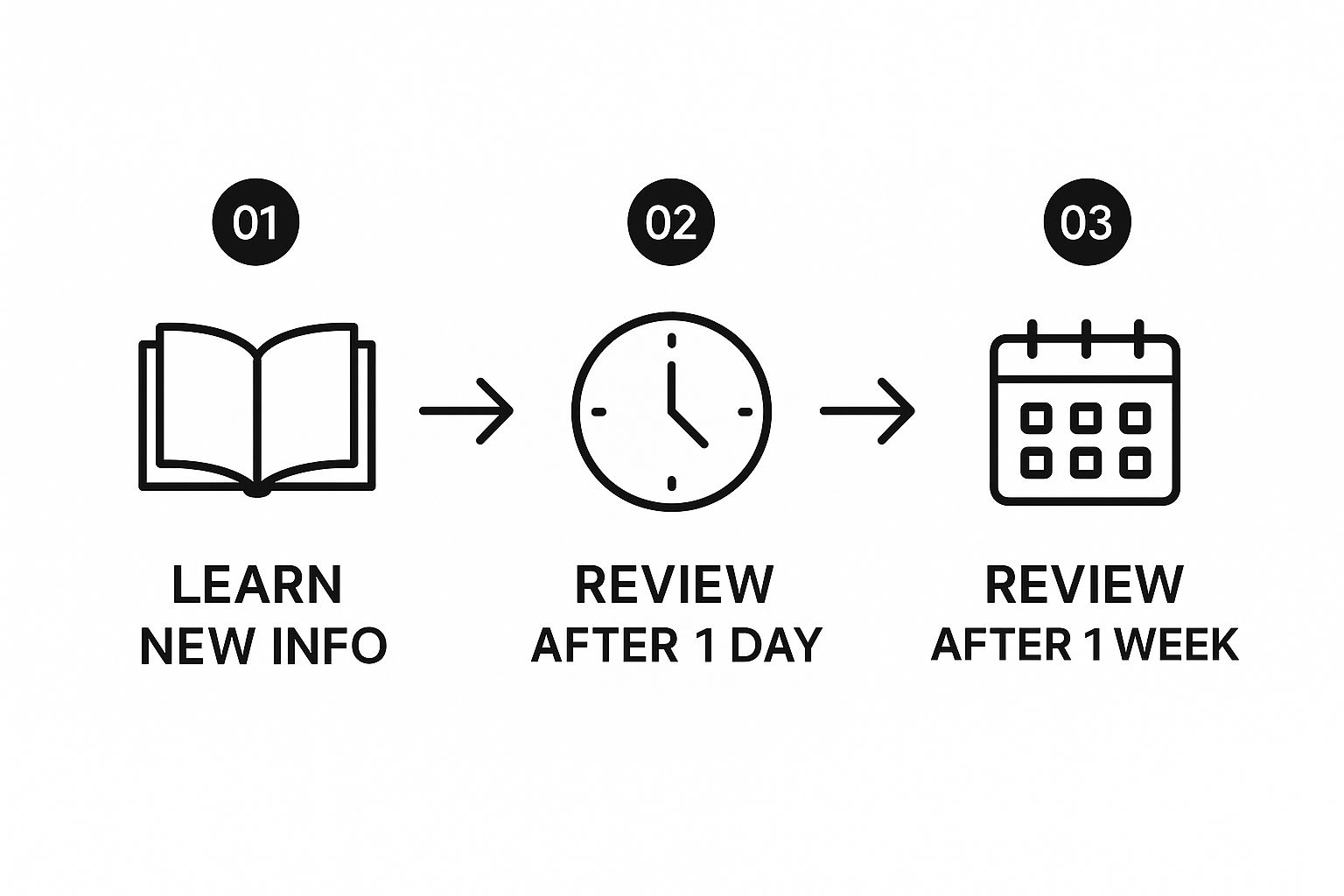How to Retain Information Better with Proven Techniques

Ever finish a book or a meeting and find yourself struggling to recall the key details just a week later? It happens to all of us. The secret to making information stick isn't about reading more, but about moving beyond passive consumption and embracing active learning strategies like recall practice and spaced repetition. These methods are designed to force your brain to build stronger, more durable connections to what you learn.
Why We Forget So Much and How to Stop It

That frustrating feeling of losing important information isn't a personal failure. It’s a fundamental aspect of how our brains are wired, a concept often explained by the Forgetting Curve. In simple terms, this curve shows that our memory for new information drops off a cliff unless we deliberately do something to reinforce it.
Without any active effort, we can lose a staggering 50-80% of what we've learned within just a couple of days. But here’s the good news: you can fight back against this natural decay. The key is to shift your mindset from being a passive consumer of information to an active participant in your own learning.
Adopting a Smarter Learning System
This guide will walk you through powerful, science-backed strategies to build a reliable system for memory retention. We’re going to move past basic note-taking and show you how to turn your digital notes into a dynamic "second brain." The goal is to create a workflow where learning, remembering, and connecting ideas become a natural, almost effortless habit.
You'll learn how to properly implement these core methods:
Active Recall: This is the act of actively pulling information from your memory, which builds far stronger neural pathways than simply re-reading your notes.
Spaced Repetition: A proven technique that involves reviewing information at increasing intervals, perfectly timed to interrupt the forgetting process.
Associative Note-Taking: This is all about building a web of knowledge by linking related ideas, which mirrors how our brains naturally learn and helps spark new insights.
"The act of remembering is what strengthens memory. Passive review gives the illusion of knowing, but active recall proves it."
By applying these techniques, you can completely transform how you learn. A tool like Obsibrain is built from the ground up to support these exact workflows. For example, as a student, you can use it to structure lecture notes into question/answer toggles for easy active recall. A professional might use its automated review system to keep track of key details from project meetings, ensuring nothing falls through the cracks. It’s all about ensuring that what you learn actually sticks for the long haul.
To give you a clearer picture, here's a quick breakdown of the strategies we'll be covering.
Key Memory Retention Strategies at a Glance
Active Recall
Actively retrieving information from memory without looking at the source.
Creates strong, durable neural pathways for long-term retention.
Spaced Repetition
Reviewing information at increasing intervals over time.
Interrupts the natural forgetting process at optimal moments.
Associative Note-Taking
Linking related ideas and concepts together to form a connected web.
Mimics the brain's natural learning process and sparks new insights.
Each of these techniques builds on the others to create a powerful system. Now, let's get into the practical steps for each one.
Using Active Recall to Build Stronger Memories

If you're like most people trying to learn something new, you've probably fallen into the passive review trap. We all have. It's that familiar habit of re-reading notes, highlighting passages, or summarizing text. It feels productive, but honestly, it’s one of the worst ways to build knowledge that actually sticks.
To really make information part of you, you need to switch gears to active recall. This is the simple act of pulling information out of your memory, rather than just passively stuffing it in. Think of it like a mental bicep curl. The more you force your brain to retrieve a piece of data, the stronger that neural connection becomes, making it easier to pull up later.
Transform Your Notes From Static to Interactive
One of the easiest ways to start practicing active recall is to change how you structure your notes. Stop writing passive summaries. Instead, reframe your key takeaways as questions. This tiny shift turns a document you just read into an interactive study tool you can use to test yourself.
This is a workflow that feels incredibly natural inside Obsibrain. You can use toggle lists to create a simple, effective study guide on the fly.
Write your question as the main bullet point. A student learning a new language could ask, "What are the key exceptions to the subjunctive mood in Spanish?"
Nest the answer inside the toggle. This keeps it hidden, so you won't accidentally spoil it for yourself.
Test yourself regularly. When it's time to review, read the question and try to answer it from memory before clicking the toggle. Then, reveal the answer to check how you did.
This process forces you into retrieval practice every single time you review. It's worlds more effective than just skimming your notes.
The Science Behind Retrieval Practice
This isn't just a productivity hack; it's backed by a ton of research. Study after study has shown that active recall blows passive review out of the water for long-term retention. In fact, students who use practice tests or try to generate answers from memory can boost their retention by up to 50% more than those who just re-read or highlight.
Active recall is the difference between recognizing a fact and truly knowing it. Recognition is easy; recall is what builds mastery.
Another classic way to put active recall into practice is by creating flashcards that actually work. Whether you use physical cards or a digital app, the principle is the same: you're forcing your brain to retrieve the answer before flipping the card. That deliberate effort is what makes the information stick.
Whether you're using toggles in Obsibrain or a dedicated flashcard app, the core principle of retrieval is the real key to a better memory.
Beating the Forgetting Curve with Spaced Repetition
If active recall is how you forge strong memories, then spaced repetition is how you keep them from rusting over time. It's a surprisingly simple, yet powerful, system for reviewing what you've learned at strategic intervals. The whole idea is to interrupt the natural "Forgetting Curve" right before a memory completely fades away.
Think of it this way: every time you successfully pull a piece of information from your memory, that neural connection gets a little stronger and lasts a bit longer. Instead of cramming—which we all know leads to forgetting almost everything a week later—you revisit information just as it's about to slip away. This act of retrieval reinforces the pathway, making the knowledge stick for good.
This infographic breaks down the basic flow for getting a simple spaced repetition system up and running.

As you can see, spacing out your reviews—maybe after a day, then a week, then a month—builds a sustainable rhythm for making your learning last.
A Simple System You Can Start Today
You don't need fancy, complicated software to make this work. A lightweight and effective system can be built right inside your notes, especially if you're using a tool like Obsibrain. This approach is great because it integrates directly into your existing knowledge base and gives you total control.
Here’s a straightforward way to create a manual spaced repetition workflow in Obsibrain:
Tag your new notes. For instance, a manager learning a new leadership framework can tag a key concept with
#review-1-day. This earmarks the note for its first review.Update the tag after each review. The next day, when that note pops up and you review it, simply change the tag to
#review-1-week. As you successfully recall the info, you can keep extending the interval:#review-1-month,#review-3-months, and so on.Build a review dashboard. Use Obsibrain’s query feature to create a dynamic list that pulls in all notes tagged for review on any given day. This creates an intelligent system that automatically tells you what to remember, right when you need to.
This manual system is a fantastic way to figure out how to retain information better without getting bogged down by yet another app.
Spaced repetition isn’t about studying more; it’s about studying smarter. It works with the brain's natural tendency to forget, using that process to your advantage by reinforcing memories at the most critical moments.
The Proven Power of Spacing
This isn't just a neat trick; the effectiveness of spaced repetition is incredibly well-documented. Research in cognitive psychology consistently shows it dramatically improves long-term memory.
In fact, some studies have found that learners using this method can retain up to 80% of new information four months later. Compare that to cramming, where retention can drop to as low as 30% in the same timeframe.
This simple, structured approach ensures that the time you put into learning actually pays off with knowledge that sticks around. And for those who want a more automated approach within their note-taking system, Obsibrain has detailed guides for setting up periodic reviews that can streamline this entire process. By systematically revisiting what you know, you're building a truly robust and reliable second brain.
Connecting Ideas to Create a Web of Knowledge
 Our brains don’t file information away in neat, isolated folders like a computer. They’re much more interesting. They build a rich, spiderweb-like network where ideas are interconnected. If you want to genuinely learn something and have it stick, you need to mimic this natural process by actively linking concepts together.
Our brains don’t file information away in neat, isolated folders like a computer. They’re much more interesting. They build a rich, spiderweb-like network where ideas are interconnected. If you want to genuinely learn something and have it stick, you need to mimic this natural process by actively linking concepts together.
This approach, often called associative note-taking, goes way beyond just jotting down individual facts. It’s all about building the relationships between those facts. Every new link you forge strengthens your understanding and carves out another mental pathway to retrieve that information later on.
Building Your Personal Knowledge Web
The most direct way to put this into practice is by using bidirectional links inside your notes. Unlike a standard, one-way hyperlink, a bidirectional link connects two notes so the relationship is visible from both ends. This creates a powerful, growing web of knowledge that becomes more valuable with every connection you make.
Let's say you're a content creator researching a new video.
You start a note called "Video Script: The Future of AI."
Inside that note, you mention the importance of "Large Language Models" and link that term to an existing note you have on the topic.
Later, while reading up on LLMs, you learn about "Transformer Architecture" and link out to a dedicated note for that.
Just like that, these three concepts are connected. Now when you look at your "Large Language Models" note, you’ll see it’s linked to both "Video Script: The Future of AI" and "Transformer Architecture," giving you instant context without having to search for it.
Connecting ideas doesn't just improve recall; it’s the foundation for generating new, original insights. When you see how two seemingly separate concepts relate, you create a spark of understanding that wouldn't happen if they were stored in isolation.
An Obsibrain Workflow for Associative Linking
Tools like Obsibrain are built from the ground up on this very principle. Linking notes is a core feature, making it incredibly simple to weave your knowledge together as you learn. As you capture new information, get in the habit of constantly asking yourself: "What does this relate to that I already know?"
For a researcher, this is invaluable. Imagine you have a note on a study about "Spaced Repetition." You can link it directly to your note explaining the "Forgetting Curve," since one is a direct solution to the other. That "Forgetting Curve" note might then connect to a broader concept like "Cognitive Biases," showing how our brains are naturally wired for certain memory errors.
This simple act of linking transforms your notes from a static archive into a dynamic, explorable "second brain." As you build out this web, you create multiple pathways to the same piece of information, and that redundancy is a huge memory aid. You’ll also find it easier to add new thoughts using the quick capture and notes feature, which lets you jot down ideas and link them to existing concepts on the fly. No insight ever gets lost.
Optimize Your Mind and Body for Learning
Learning techniques are powerful, but they're only half the story. To really figure out how to retain information better, you also have to optimize the hardware—your brain.
This means creating the right biological conditions for learning, and that starts with the non-negotiable foundation of good sleep.
Sleep is when the real magic of memory consolidation happens. While you're resting, your brain is surprisingly busy, working hard to sort, organize, and store everything you learned that day. Skipping sleep is like asking a librarian to catalog a truckload of books in five minutes. It’s just not going to happen, and most of that information will get lost.
Prioritize Sleep for Better Recall
This isn't just a nice idea; the link between sleep and memory is solid. Experimental data shows that people who get a full 7 to 8 hours of sleep after a learning session have a 20-30% better recall rate compared to those who are sleep-deprived.
You can seriously improve your sleep hygiene with a few simple habits:
Keep a consistent schedule: Try to go to bed and wake up around the same time every day, even on weekends. Your body loves a routine.
Create a pre-sleep wind-down: Put the screens away at least an hour before bed. Grab a physical book or listen to some calming music instead.
Optimize your bedroom: Make it dark, quiet, and cool.
These small adjustments send clear signals to your brain that it's time to shut down, paving the way for the deep, restorative sleep you need for memory consolidation.
Cultivate Deep, Undivided Focus
Just as important as sleep is what you do when you’re awake and trying to learn. Multitasking is the absolute enemy of memory.
When you're trying to learn something new while also checking emails or scrolling through social media, you fragment your attention. This torpedoes the initial encoding of the memory, making it nearly impossible to recall later, no matter how many times you review it.
To really get why this is so critical, it's helpful to understand a bit about Cognitive Load Theory, which explains exactly why overloading your working memory is such a disaster for learning.
"Deep focus during learning is like using a high-resolution camera to take a picture. Multitasking is like trying to capture the same image with a blurry, shaking lens—the initial quality is so poor that no amount of editing can fix it later."
In Obsibrain, you can create a simple "Learning Log" template to keep tabs on your focus levels and how long you're sleeping. For example, a developer learning a new coding language could track their hours of focused "deep work" each day alongside their sleep duration. By monitoring these habits, you'll start to see clear patterns emerge between your daily routines and how well you're actually retaining complex information. Obsibrain’s built-in habits tracking is perfect for this, letting you see your progress and make smart adjustments to your lifestyle for much better learning outcomes.
Your Questions, Answered
As you start weaving these methods into your daily routine, you're bound to have some questions. It’s only natural. Let's walk through some of the most common ones that come up, so you can sidestep the usual hurdles and really get this system working for you.
How Long Until I See Real Results?
You'll probably notice small wins almost right away. Try using active recall in a single study session, and I'll bet you remember more the next day. It’s that immediate.
But for the big, lasting changes—that feeling of having a truly reliable memory—you need to give it a little time. Most people start to feel a significant difference after about 3-4 weeks of consistent effort. The goal isn't to force it; it's to build a habit that feels like a natural part of how you learn.
This is where a tool like Obsibrain can be a game-changer. For a consultant, you can use its project templates and periodic review prompts to ensure you're consistently applying these techniques to your client work. This helps bake these practices into your workflow, so you don't even have to think about it.
Can I Use This for Work Meetings and Not Just Studying?
Absolutely. In fact, this is one of the most powerful applications. Most people let their meeting notes die in a folder somewhere. Instead, you can turn them into active knowledge you can actually use.
Here's a quick workflow I use in Obsibrain after every important meeting:
Brain dump first. After the meeting, I open my Daily Note and use a template to quickly jot down everything I can remember: key decisions, action items, and who is responsible.
Fill in the blanks. Now, I’ll pull up my raw notes and compare. That act of spotting what I missed is an incredibly potent way to strengthen the memory.
Make connections. I'll link key decisions to project pages or notes on the team members involved. It builds a rich web of context.
Tag it for later. A simple tag like
#review-tomorrowis all it takes. This ensures I give it a quick once-over the next day, locking it in.
This simple process transforms passive minutes into actionable intelligence, making you far more effective and on top of your game.
Should I Try to Use All These Techniques at Once?
That's a classic mistake, and it's a surefire way to get overwhelmed and quit. The best way to make this stick is to start small. Pick one thing and get good at it.
My advice? Start with active recall. It gives you the biggest bang for your buck right away. For one week, make it your only goal to turn every new note you take into a set of questions and answers. Just get a feel for it.
Once that starts to feel second nature, maybe you can bring in spaced repetition with a simple tagging system for reviews. Associative linking often happens on its own as your vault of notes grows and you naturally start seeing connections. Building a robust learning system is a marathon, not a sprint. Master one piece at a time.
Ready to stop forgetting and start building a reliable second brain? Obsibrain is the all-in-one template for Obsidian that integrates these science-backed learning techniques directly into your workflow. Take control of your knowledge and start retaining what truly matters by visiting https://www.obsibrain.com/en today.
Last updated
Was this helpful?